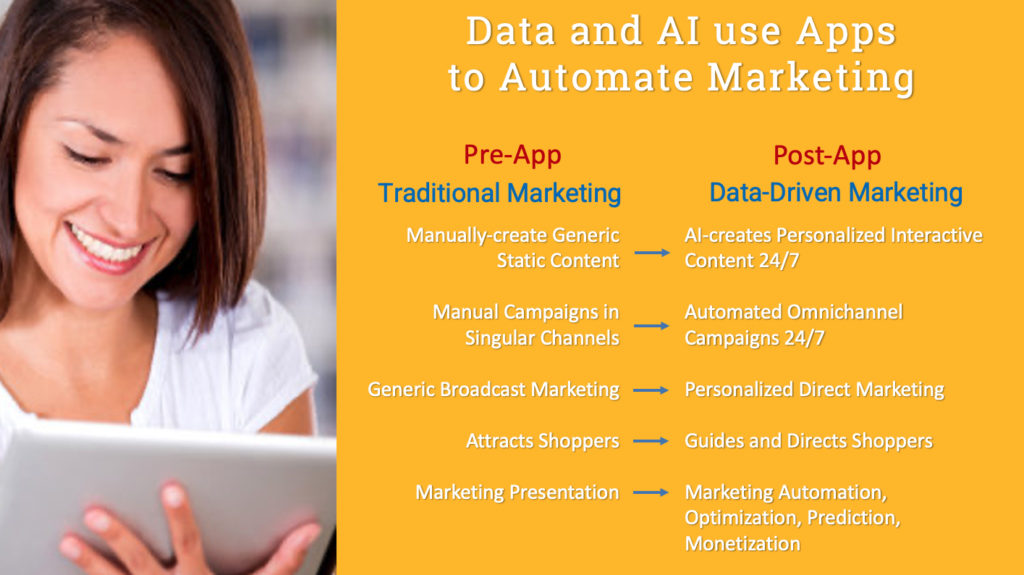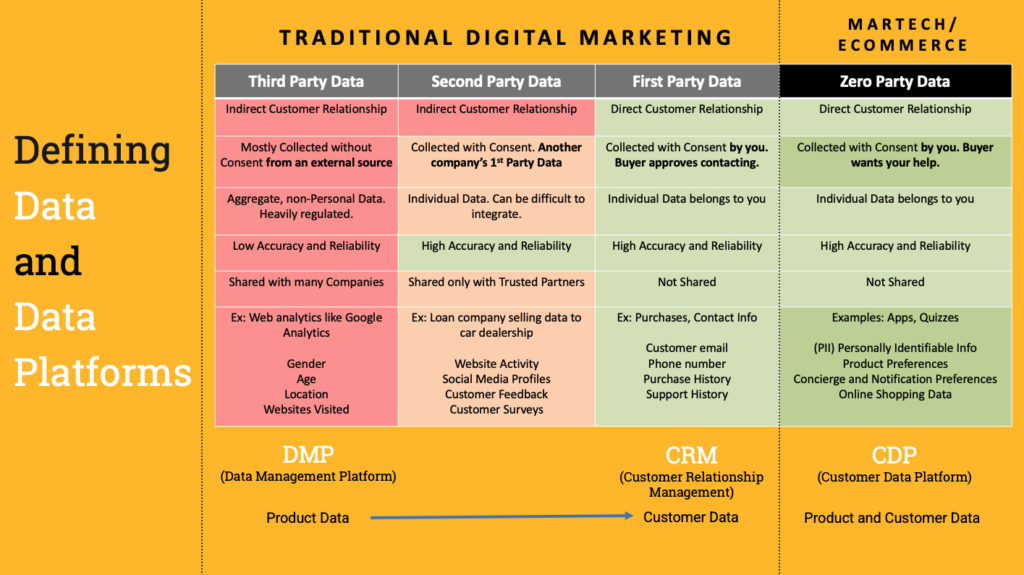A New Go of New Home Sales!
with John and Anya
Episode 8, February 8, 2022
Data is Gold! Defining, Mining, Refining and Monetizing Data
Data is the analytical left-brain side. It’s what Technologists do best. Are you effectively monetizing that goldmine of data? Digitally mine it with the right marketing reaction to every online action. With AI, little bits of data are refined into precious nuggets of information. Let’s dig deeper!
Today, we’re talking about data. We’re going to get into the details here, the nitty gritty and we’re going to discuss how to define, mine, refine, and monetize data. The secret formula to success which has stood the test of time is that content is king, plus data is gold and together that equals great knowledge, which gives you great power. Traditionally, content has been the purview of marketing, which is more the creative right brain side. Marketing’s main focus is on the form, and function is the data aspect of it. Data is more the left brain side. Now, MarTech brings marketing and tech together, and that’s the combination of form and function.
The problem begins as the whole world is going online, e-commerce changes everything. The secret formula still applies. Content is still king. Data is still gold and together knowledge is great power. But in the online world, you need to have interactive content. Engaging, interactive content is very important because we need to capture online shopping data, not just of what they’ve looked at, but how they’ve interacted with that. It can’t possibly be done by a human, so we need the help of artificial intelligence (AI). You couldn’t pay anyone enough
money to stay up 24/7 to analyze billions of bytes of data.
The superpower of AI is it gives us those hidden connections that our human brain can’t make. So it knows if you’re fumbling around through some things that other people have fumbled through before, and it can deliver the right product and recommendations to where you are in the sales funnel, based on your predecessors and based on the actions that you have engaged with online.
But AI is dumb without data. It’s kind of like your smartphone is so smart, but if it doesn’t have any power, it’s just a paper weight. Together AI and data can make your eCommerce data much more meaningful and practical, while enabling marketing automation. Now, how does this data and AI come together? Through apps.
Pre-app, the traditional marketing approach required builders to manually create generic static content. That manual process is very time consuming, very costly, and it’s not personalized at all. Apps enable data-driven marketing. Here is a comparison of pre-app versus post-app marketing:

The other part of a pre-app traditional marketing is not only that the content is manual, but the campaigns are manual. In a post-app world, it’s not only automated, but they are also coordinated omnichannel campaigns. So it’s sending out the right messages, on the right platforms, to the right people, at the right time, wherever they are.
The other part of a pre-app world is you’re doing very general broadcast marketing. In a post-app world using AI, it becomes personalized, direct marketing. Not only does it engage the shopper, but it guides and directs the shopper. So ultimately, you’re going to shift to a higher level of marketing – you’re going from basic marketing presentation, using static, generic marketing, to the post-app world marketing automation, marketing optimization, prediction, and monetization.
How do we create data-driven engagement using AI? Marketing should focus on what they do best, which is creating that wonderful, great content. So you present a generic house and you add it to the database, which is the cloud. The buyer begins to engage with this basic content by taking the generic house and personalizing it online.
So they’re able to not just accept and reject the AI’s suggested match, but they’re able to then customize that match. And if they actually purchase that house, it feeds that information back and then the AI says don’t show that farmhouse with the red door show it with the black door instead as people prefer it. So it enhances your starter content to make it even more attractive for round two.
Let’s define data and where it resides. There are four types of data. In traditional marketing, there’s a third party data, second party data, first party data. And now with online shopping, you can actually go down to zero party data, which is really where people want to go, because that is ground zero to how customers want you to service them.

If you look at the chart, the things in red are not good. The things in darker green are really good. So on third party data, you have an indirect relationship. And the other thing is as you go across these data platforms, you’re moving from product data to customer data, so as you go from
third to second to first to zero data, your focus is more and more about the customer, which is the way it should be.
So what’s the zero party data? Zero party data has everything that first party data offers, but the big difference is that not only do you get to collect it with consent, but the shoppers actually want you to help them. They actually want you to provide a concierge service. So they’re not only just giving you their personal contact information, they’re telling you not only who they are, but what they want and like. Zero party data is gathered through examples like quizzes or surveys.
Zero party data is really valuable and critical, and valued for very consultative, complex purchases that have huge impacts on your life-like building a new home. Zero party is the goal, but here’s where the data platform could be your inhibitor. If you’re still using static websites, you’re not going to get that engagement. You’re not going to get that personalization. Even if the people are willing to fill out a quiz, you couldn’t deliver them anything because your content is static.
The third party data lives on what’s called a data management platform-DMP. Google is built on a DMP platform. It’s product-centric and it’s not personalized. On the other end of the spectrum is a CRM-customer relationship management system. Its focus is the customer, not the product. Why couldn’t they put the two things together? CRM plus a DMP does not equal a CDP. CDP overlaps both the CRM and a DMP. The CDP improves customer experience online, which is something that neither of the CRM or the DMP can do because it’s not tied to an online experience. CDP turns e-commerce data into AI gold.

To utilize the data, the system takes all those bits and bytes through a process of data processing and refinement. It collects all this data from all these omni-channel sources. Then, it organizes it in a way that’s meaningful to the marketing person or salesperson. It activates trigger
events to serve the right personalized message and content to where shoppers are at in the shopping funnel and involves a salesperson if needed. So it’s a great hand-off from the virtual, online world to the real world.

The front-end is what the buyer sees-websites, social, email, portals, etc. But the back-end is where the builder systems are. And builders have a ton of systems. They have everything from MLS to ERPs. Our product is visual and buyers speak visually. Our cloud rendering engine translates from buyer speak to builder speak (data) back to buyer speak all instantaneously online. But it’s also supporting another thing which hasn’t been utilized in this industry, which is what we’re creating: artificial intelligence. As we’re feeding all these systems pricing information, lot availability, color schemes, floor plan options, etc.; it’s also feeding AI.
Buying or building a home is the most personable thing that you could ever do because you’re making so many decisions. You’re basically telling the builder who you are, what you like and how you live your life. It’s much more than the information that you’ve shared with Facebook or even Amazon, because it’s everything from your bedroom to your bathroom, to your kitchen, all of your personal preferences.
So now let’s talk about monetizing that gold and e-commerce. Silicon is the new oil and data is the new black gold today. We take all that oil in a sense, and we’re able to use technology to distribute it to the gas stations and ultimately to the vehicles. So the technology distributes the content to the consumers.
Apps make all the difference, because as you’re utilizing AI in real time, you’re looking into the future. You’re seeing where the trends are going. One thing that we’ve seen in the last five years is a proliferation of channels. Especially as social becomes more commerce. You have to be everywhere every time, all the time at the right time with the right product. The only way you do that is with an app.
This is going to be exciting time for new home sales. Because again, we generate so much personal data. Personalization is the number one reason why people buy new-they want personalization and that’s gonna extend into marketing and ultimately, help us sell more homes.
PRESENTATION SLIDES
Email Me New Episodes
Join our private email list to receive reminders of new episode releases, exclusive content and market insights. Your contact information will not be shared with others and you can unsubscribe at any time.
We welcome everyone – whether you are a customer, competitor, partner or just interested in our New Homes industry. We hope that together, we can enlighten ourselves, strengthen our relationships, grow our industry and better service our customers.
Follow Anewgo on LinkedIn




